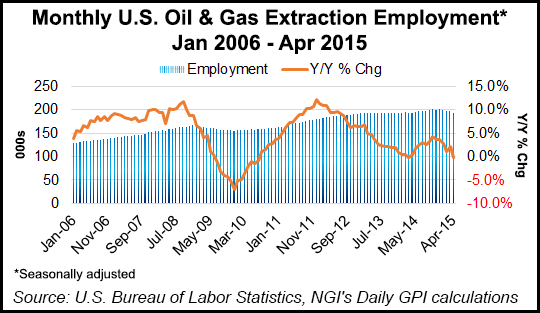Labor Department Says Thousands of Oil, Gas, Support Jobs Lost in April
In the wake of collapsed world crude oil prices, the United States shed more than 3,000 oil and natural gas extraction jobs in April, and the unemployment rate in the sector has surged to 8.7%, according to data from the U.S. Department of Labor’s Bureau of Labor Statistics (BLS).

On Friday, BLS reported that an additional 10,200 jobs that support mining activities were also lost in April. Those jobs include a North American Industry Classification System (NAICS) subsector for oil and gas jobs — specifically, NAICS 211, which includes, among other things, exploration and production, drilling and completing wells, hydraulic fracturing (fracking), field gathering lines and the recovery of natural gas liquids.
According to BLS, there were 194,400 seasonally adjusted oil and gas extraction jobs in the United States in April, a loss of 3,300 jobs and a 1.7% decline from March, when there were 197,700 jobs in the sector. The latest total was just slightly below (0.1%) April 2014, when there were 194,600 jobs.
But there were steeper losses among jobs that support mining activities. BLS reported that the number of jobs in that sector declined 2.4%, from 424,300 in March to 414,100 in April.
BLS also reported Friday that the not seasonally adjusted unemployment rate for mining, quarrying, and oil and gas extraction had climbed to 8.7% in April, compared to 3.8% in April 2014. The bureau said there were 83,000 unemployed workers from that sector in April, compared to 39,000 the preceding April.
The not seasonally adjusted unemployment rate for mining, quarrying, and oil and gas extraction was the highest for non-agricultural private wage and salary workers. The rate was second-highest among all industries and class of worker; agriculture and related private wage and salary workers had the highest unemployment rate, 12.2%.
Nationally, BLS said the unemployment rate for April remained unchanged at 5.4%. The number of unemployed persons was also essentially unchanged, at 8.5 million.
© 2024 Natural Gas Intelligence. All rights reserved.
ISSN © 1532-1231 | ISSN © 2577-9877 | ISSN © 1532-1266 |
